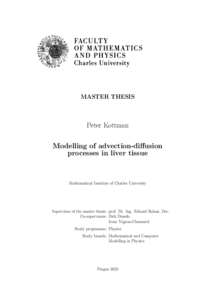Modelování advekčně-difúzních procesů v jaterní tkáni
Modelování advekčně-difúzních procesů v jaterní tkáni
diploma thesis (DEFENDED)

View/
Permanent link
http://hdl.handle.net/20.500.11956/181725Identifiers
Study Information System: 258418
Collections
- Kvalifikační práce [11325]
Author
Advisor
Referee
Souček, Ondřej
Faculty / Institute
Faculty of Mathematics and Physics
Discipline
Mathematical and Computational Modelling in Physics
Department
Mathematical Institute of Charles University
Date of defense
7. 6. 2023
Publisher
Univerzita Karlova, Matematicko-fyzikální fakultaLanguage
English
Grade
Excellent
Keywords (Czech)
advekčně-difúzní procesy|bilanční vztahy|redukované modely|mikrocirkulace|numerické simulace|metoda konečných objemůKeywords (English)
advection-diffusion processes|conservation laws|reduced models|microcirculation|numerical simulations|finite volume methodV súčasnosti sa v ľudskej populácii čoraz častejšie vyskytujú ochorenia pečene, pri- čom niektoré z nich majú vysokú úmrtnosť. Pochopenie a účinná liečba týchto ochorení si vyžaduje multidisciplinárny prístup systémovej medicíny, ktorý spája experimentálne výsledky, teoretické modely a klinickú prax. Súčasťou tohto úsilia je niekoľko nedávnych štúdií modelujúcich prúdenie a transport v častiach pečeňovej mikroštruktúry. Cieľom tejto diplomovej práce je odvodiť deskriptívny redukovaný matematický model trans- portu fluorescenčných látok v sinusoidách a žlčových kanálikoch v pečeňovom laloku spolu s výmenami s okolitými hepatocytmi. Motivovaní nedávno publikovanými modelmi vychádzame z úplných 3D bilančných rovníc pre zmes triedy I, prezentujeme ich redukciu na 1D rovnice pozdĺž osi modelovej oblasti a uvádzame prototypy numerických výsledkov, pričom diskutujeme o ďalšom rozšírení modelu s ohľadom na vyššie uvedený multidiscip- linárny výskumný kontext. 1
In the modern day, various liver diseases have become increasingly widespread in the human population, some having important mortality rates. Understanding and efficient treatment of these diseases requires a multidisciplinary approach of systems medicine, combining both experimental and modelling fields, as well as clinical practice. As part of such efforts, there have been several studies in the recent years modelling flow and trans- port in parts of liver micro-architecture. The work presented in this master thesis aims to formulate a descriptive reduced mathematical model of fluorescent marker transport in both sinusoidal and bile canalicular networks in the liver lobule, along with exchanges with neighboring hepatocytes. Motivated by approaches presented in recently published research, we start from a full 3D model for a Class I mixture, present its reduction into 1D equations along the vessel axis, and show proof-of-concept numerical results, discussing further extensions of the model in view of the multidisciplinary research context outlined above. 1
